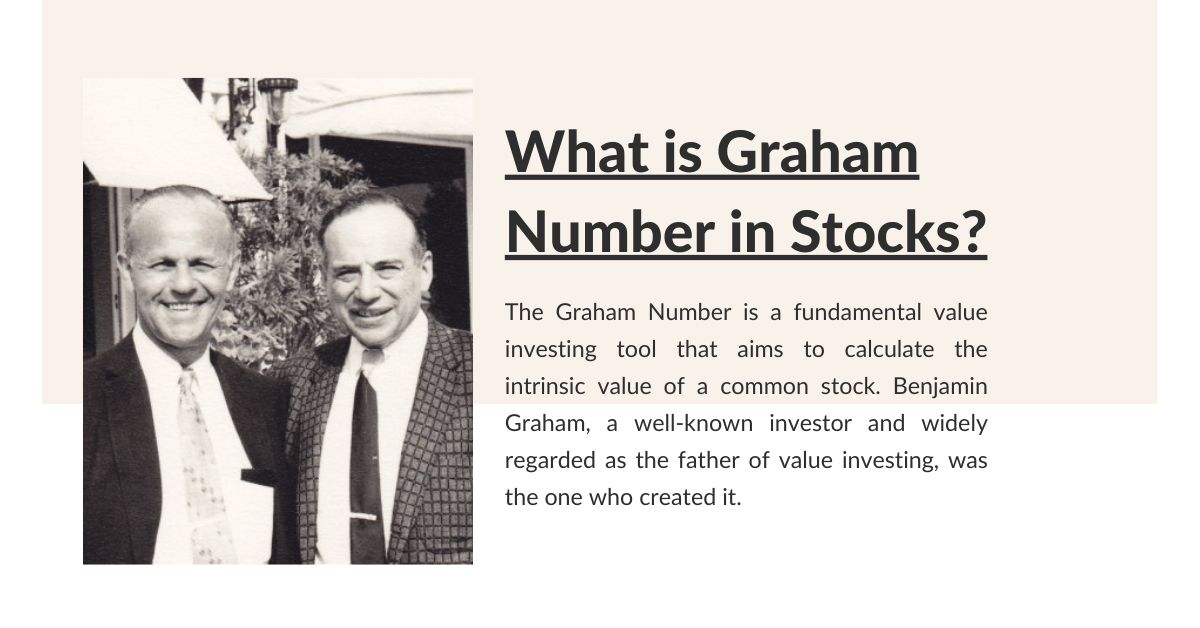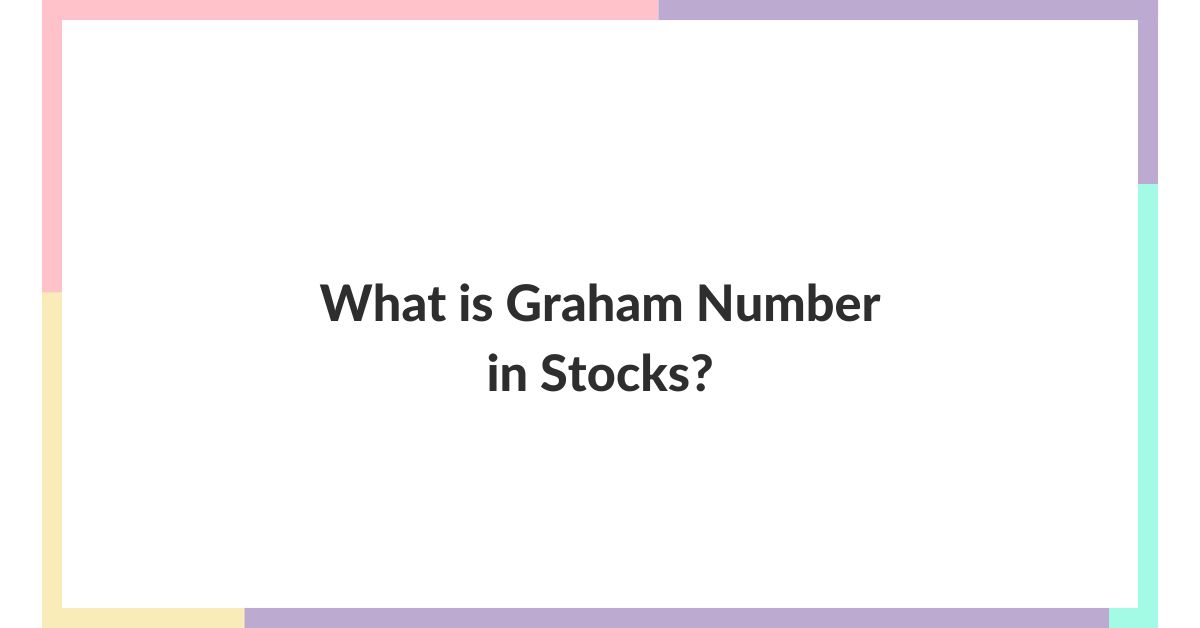We’ll discuss the Graham Number in this post because Benjamin Graham, known as the “father of value investing,” created it. This method allows investors to quickly assess a stock’s intrinsic value using its earnings per share (EPS) and book value per share (BVPS). The Graham Number is very valuable for value investors looking for companies with a margin of safety, particularly in solid industries such as utilities, consumer staples, and industrials.
This article describes Graham’s approach and formula, including how to calculate and interpret the results. We’ll walk through a full example of the process using a real-world organization. Furthermore, we will address the limits and practical uses of this valuation approach.
What is Graham Number in Stocks?

The Graham Number is a fundamental value investing tool that aims to calculate the intrinsic value of a common stock. Benjamin Graham, a well-known investor and widely regarded as the father of value investing, was the one who created it.
Graham Stocks Formula
The Graham Number formula is calculated as follows:
Graham’s Number = √(10 * E * P/E)
where:
- E is earnings per share.
- P/E is the price-to-earnings ratio.
The Graham Number is a metric for analyzing whether a company is cheap or overpriced. If a stock’s current market price is less than its Graham Number, it is deemed undervalued and may represent a good investment opportunity. If the current market price exceeds the Graham Number, it is deemed overvalued and may be a dangerous investment.
It’s important to highlight that the Graham Number is a basic statistic with limits. It ignores elements like growth potential, firm quality, and industry-specific dynamics. Short-term swings in profits and stock prices may also have an impact on the Graham Number.
As a result, while the Graham Number is an effective tool for spotting possibly cheap equities, it should not be utilized in isolation. Before making an investment decision, investors ought to look at all relevant elements and undertake extensive research.
Example of Graham Number
Let’s say we’re examining a corporation with the following financial metrics:
- EPS: ₹50.
- Price to Earnings Ratio (P/E): 15
Using the Graham Number Formula:
Graham Number = √(10 * E * P/E) = √(10 * 50 * 15) = √7500, about 86.60.
Undervalued stocks are those with a current market price below ₹86.60, according to the Graham Number. For example, a stock selling at ₹70 is deemed inexpensive according to this criterion.
Graham Rules for Investing
Benjamin Graham, a well-known investor and the founder of value investing, laid forth six important ideas that serve as the basis for his investment philosophy. These ideas, also known as Graham Rules, highlight the significance of:
- Margin of Safety: Investors should always look for a large margin of safety between the price they pay for a company and its true value. This helps reduce potential losses.
- Fundamental Analysis: A detailed examination of a company’s financial statements, business strategy, and industry dynamics is crucial for spotting cheap stocks.
- Contrarian Thinking: Investors should be willing to go against the majority opinion and purchase stocks that are out of favor or misunderstood.
- Patience: Investing is a long-term undertaking, so investors should use caution and avoid making rash decisions based on short-term market swings.
- Diversification: To reduce risk, investors should diversify their investments across several assets and sectors.
- Avoid Speculation: Graham warned against speculative investment, which is purchasing stocks based on short-term price fluctuations rather than underlying value.
How to Use the Graham Number to Value Stocks?
The Graham Number provides a simple benchmark for determining whether a stock is undervalued or overvalued. Here’s a basic guide on how to use it:
- Calculate the Graham Number: Use the formula: Graham Number = √(10 * E * P/E), where E is Earnings per Share and P/E is the Price-to-Earnings ratio.
- Compare to Current Price: If the current market price of the stock is significantly below the Graham Number, it might suggest that the stock is undervalued. Conversely, if the price is significantly above the Graham Number, it might indicate overvaluation.
- Consider Other Factors: While the Graham Number can provide a helpful starting point, it’s essential to consider other factors such as:
- Company Quality: Is the company financially sound and has a sustainable business model?
- Growth Potential: Does the company have opportunities for future growth and expansion?
- Industry Trends: Is the industry the company operates in experiencing favorable or unfavorable trends?
- Competitive Landscape: How strong is the company’s competitive position?
Remember, the Graham Number is simply one of several tools used in value investing. Before making an investment choice, extensive study and analysis are required.
If you want to read another factor like Graham Number in stocks, you can also read this:
Limitations of Graham Number
While the Graham Number can be a useful tool for spotting possibly inexpensive companies, it has several drawbacks.
- Simplicity: The Graham Number is a straightforward indicator that excludes numerous elements that might impact a stock’s value, such as growth potential, competitive advantage, and industry dynamics.
- Historical Focus: The method is based on past data (earnings per share and price-to-earnings ratio), which may not properly predict future performance.
- Short-term swings in profits and stock prices can have an impact on the Graham Number, resulting in misleading valuations.
- Neglects Qualitative factors: The Graham Number prioritizes quantitative considerations and ignores qualitative aspects such as managerial quality, corporate culture, and competitive advantages.
- Industry-Specific Differences: Because valuation factors vary by industry, the Graham Number may not be equally relevant to all industries.
Who Was Benjamin Graham?
Benjamin Graham, an iconic American investor and professor, is often regarded as the founder of value investing. He is well known for his book “The Intelligent Investor,” which is widely regarded as one of the most important financial manuals of all time. Graham’s investing theory highlights the value of basic study, margin of safety, and long-term thinking.
He felt that investors should prioritize buying stocks at a large discount to their underlying worth above chasing short-term gains. Graham’s theories had a major influence on the world of investing, and investors continue to study and apply them today.
What is a Good Graham Number for a Stock?
A “good” Graham number for a stock suggests that it is undervalued.
However, there is no set standard for what defines a “good” Graham number. The unique sector, market conditions, and the investor’s risk tolerance are just a few of the variables that affect it. A stock with a current market price much lower than its Graham Number is considered a possible bargain.

